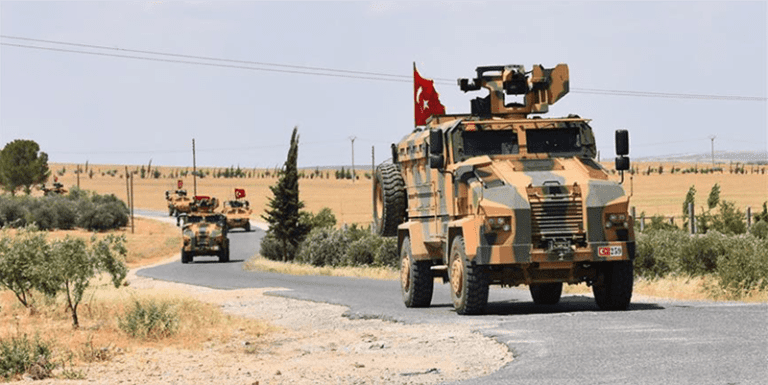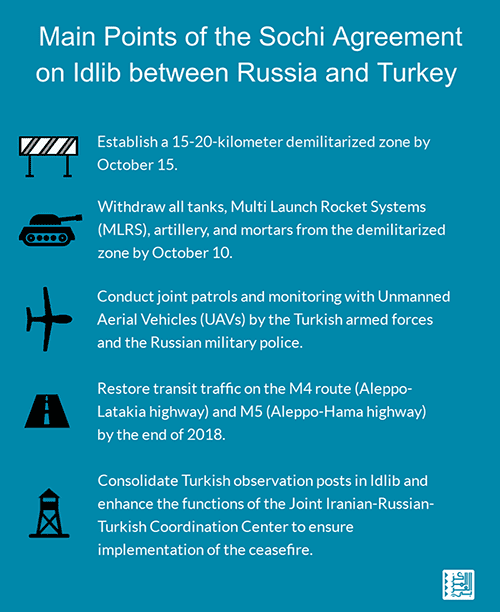
On September 17, 2018 at talks in Sochi, Russia and Turkey agreed to establish a demilitarized zone separating the Syrian regime from the armed opposition and jihadist groups in Idlib province in northwestern Syria. The Sochi Agreement was to go into effect on October 15, and by October 10, the two countries formally announced the establishment of a zone that stretches from the northern mountains of Latakia through the countryside of Hama and Idlib to the outskirts of Aleppo. The coming weeks are crucial for the agreement, which may have prevented an international crisis and a Russia-led offensive on the province. Furthermore, the full implementation of the agreement will put Russian-Turkish relations to the test since both are struggling to maintain order in and around the zone, where irregularities may doom the arrangement.
Ankara is hesitant to directly confront jihadist groups operating inside Idlib because it aims to retain influence over the province in the long term. Moscow seems intent on capturing and pushing back Turkish control along the Syrian border west of the Euphrates River. Russian Foreign Minister Sergei Lavrov described this deal with Turkey as a “temporary agreement.” Kremlin spokesperson Dmitry Peskov noted that Moscow is “satisfied with the way the Turkish side is working.” Turkish Foreign Minister Mevlut Cavusoğlu acknowledged that there are barriers in implementing the agreement, including the withdrawal of heavy weapons and “some radical groups.” Even if announced by Russian and Turkish authorities, it is difficult to confirm independently whether the militants and heavy weapons were completely withdrawn.
Rival Armed Groups in Idlib
The challenge remains as to what to do with the militants who leave the demilitarized zone, and the heavy weapons that are removed, as they spill over into other parts of Idlib. The fragmentation of security across Idlib and in the countryside of Aleppo province has increased in recent weeks. Ankara has been reinforcing its military presence and empowering the National Liberation Front (NLF) and the Syrian Liberation Front to counter the al-Qaeda-linked Hay’at Tahrir al-Sham (HTS), which controls more than half of Idlib province. After remaining silent for weeks, HTS reluctantly endorsed the Sochi Agreement on October 14 and withdrew heavy weapons and militants from the demilitarized zone. The transfer of militants is causing tensions among the rival groups in Idlib. In fact, at least 17 people were killed in the Aleppo countryside between September 30 and October 8 because of these tensions, according to the Syrian Observatory for Human Rights.
Since the signing of the Sochi Agreement, key HTS commanders were assassinated, most notably aides to HTS leader Abu Mohammad al-Julani including Abu Yousef al-Jazrawi, Abu Musaab al-Dayri, Muhammad Abu Islam, and Abu Osama al-Trabulsi (all killed last week). These targeted killings seemed to be sending a message to HTS to show more flexibility regarding the Sochi Agreement.
In addition to HTS and NLF, there are two major groups operating in Idlib province: the jihadist groups on the right of HTS that operate under the umbrella of Hurras al-Din, an alliance that was formed last February, and the armed opposition groups on the right of NFL, which operate under the umbrella of the Syrian Liberation Front, a merger between Ahrar al-Sham and Noureddine al-Zenki movement. The Syrian Liberation Front aims to continue the military operations against the Syrian regime, but it remains loyal to Turkey.
Once HTS endorsed the Sochi agreement on October 14, four jihadist groups under its umbrella defected and insisted on fighting the Syrian regime. HTS will have to make a choice between staying neutral or launching a campaign against these defections. HTS has around 30,000 fighters of which 10,000 are foreigners. Infighting inside HTS will be crucial moving forward as its leader, Abu Mohammad al-Julani, is distancing himself from the al-Qaeda leadership; moreover, Ankara is betting that HTS will dissolve itself and join the Turkish-backed opposition, a scenario that does not seem plausible at this point.
The Sochi Agreement is buying time for Turkey to strengthen its presence in Idlib while allowing HTS to remain active and defend the area from a possible Syrian regime offensive
Ankara’s role appears to give guarantees to the Syrian armed opposition that if they endorse the Sochi Agreement, neither Russia nor Iran will attack them. Turkish authorities have also been trying to defuse tensions between NLF and HTS but might come under increasing pressure from Moscow to become more decisive in extending control over the province. The Sochi Agreement is buying time for Turkey to strengthen its presence in Idlib while allowing HTS to remain active and defend the area from a possible Syrian regime offensive.
Border Crossings Are Crucial for the Buffer Zone
One major challenge is that the demilitarized zone is near the four key crossings that link together as well as separate the Syrian regime from the armed groups in Idlib. The first two crossings, al-Ayss and al-Mansoura, link the Syrian regime and opposition areas in the countryside of Aleppo. The other two crossings, Qalaat al-Madiq and Murak, connect the regime and opposition areas in the countryside of Hama.
The al-Ayss crossing in the southern countryside of Aleppo, which links on the Syrian regime side to al-Hader city, is under HTS control. It was the only crossing that remained open in the past two months. Al-Ayss is crucial for farmers in opposition areas looking to sell their products in neighboring towns that are under the control of the Syrian regime, while the al-Mansoura crossing connects the western countryside of Aleppo with areas under regime control. Al-Mansoura is currently run by the Noureddine al-Zenki movement, which is part of the Syrian Liberation Front; it was open for a brief trial period last July and could potentially become a key crossing for commercial trade and the movement of people.
Qalaat al-Madiq crossing is in the al-Ghab valley in the northern outskirts of Hama. It closed nearly two months ago when Russia gave the impression of launching the Idlib offensive, having served as the main gateway for militants who fled other parts of Syria for refusing to strike a deal with the regime. The crossing also allowed civilians to cross in both directions and has been under the control of Ahrar al-Sham Movement and Jaysh al-Nasr. Russian authorities have indicated1 that this crossing in Qalaat al-Madiq area, which serves as an agricultural and commercial storage facility, might soon reopen. The Murak crossing is in the northern outskirts of Hama on the Damascus-Aleppo highway. It was under HTS control since November 2017, but the Syrian Liberation Front took it over in February 2018. This crossing is dedicated to commercial trade activities.
The imminent reopening of the crossings will allow armed groups as well as factions in the Syrian army to be invested in stabilizing the area––but this might not guarantee the prevention of a looming confrontation
The Syrian Liberation Front has the upper hand in controlling these crossings, which became lucrative for the parties involved in the Syrian conflict because of customs fees and an expanding black market. The imminent reopening of the crossings will allow armed groups as well as factions in the Syrian army to be invested in stabilizing the area—but this might not guarantee the prevention of a looming confrontation.
The International Dimension of the Sochi Agreement
The Sochi Agreement enjoys international support; however, this has not translated into policy or direct involvement by the United States and the European Union. Russia and Turkey merely notified the United Nations and the United States of the agreement, but France was apparently unable to have the UN Security Council endorse this document and link it to the UN-led Geneva peace process for Syria. Washington, however, has explicitly given international recognition for the Sochi Agreement. During the United Nations General Assembly meetings last September, President Donald Trump thanked Russia, Syria, Iran, and Turkey for this effort to prevent an offensive in Idlib. On October 17, the US special representative for Syria engagement, James Jeffrey, said that the withdrawal of heavy weapons is “complete by all accounts” and “there is some question as to whether everybody from (HTS) has left.” The United States, however, has no leverage in Idlib; it can offer support for Turkey in increasing international pressure on Russia to maintain the status quo and refrain from launching a ground offensive in Idlib.
The fate of Idlib will in large part be defined by how Russian-Turkish relations will evolve in the coming weeks and months
The Trump Administration aims to freeze the conflict in Syria and advance a UN-led peace process while pressuring Iran politically to withdraw its forces from the country. The United States is pressuring Russia not to allow the Syrian regime to seize control of the last major stronghold of the Syrian armed opposition, since this would empower the Syrian regime to declare victory and have less motivation to concede on the political process. Given the recent US-Turkish rapprochement following the killing of Saudi journalist Jamal Khashoggi, Russia will be watching how Ankara might alter its approach in the Syrian conflict, most notably in Manbij where Washington and Ankara have been struggling to start their joint patrols. The fate of Idlib will in large part be defined by how Russian-Turkish relations will evolve in the coming weeks and months.
It is yet to be seen what impact the Sochi Agreement might have on Idlib. After all, it remains an addendum to the Astana Agreement between Russia, Turkey, and Iran. While there is no clear path forward, recent history tells us that these types of agreements are temporary and merely serve to delay confrontation.
An earlier, and shorter, version of this article was published October 17, 2018 by Al Jazeera English. It can be read here
1 Source is in Arabic.


